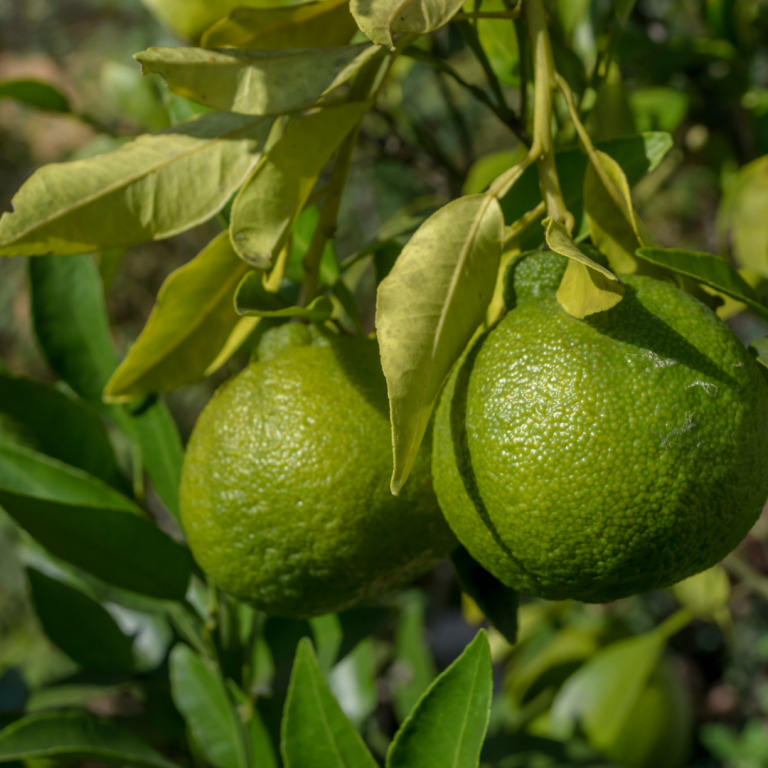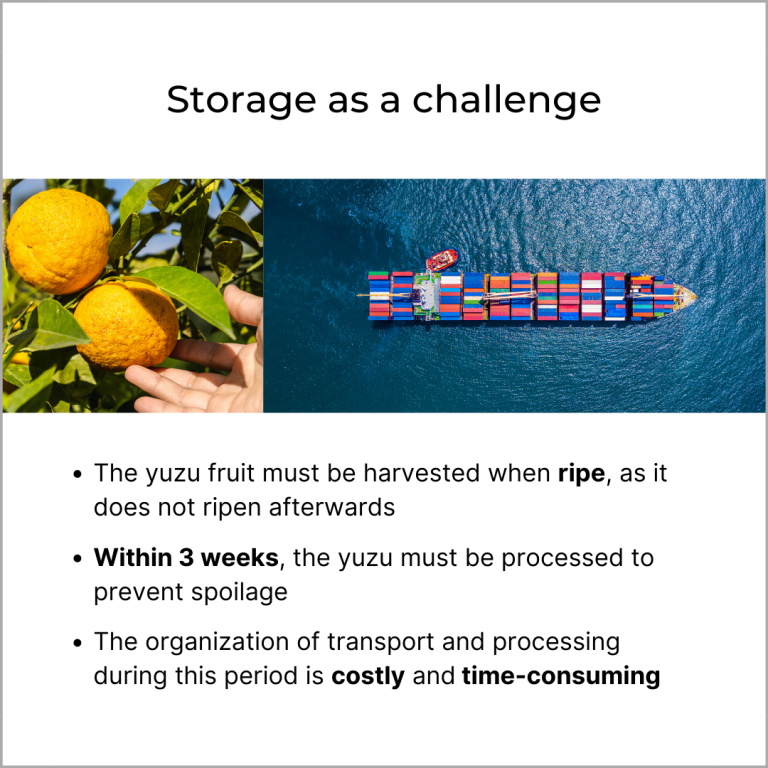FEB 10, 2023
Yuzu fruit: Understanding its potential as a key ingredient in the food industry
Yuzu (Japanese: 柚) is the name of a
yellow to orange citrus fruit with a shrivelled skin from the East Asian region. Externally, it strongly resembles a
tangerine or a
lemon. Yuzu is an increasingly common name in the vernacular, but it is especially common within the so-called foodie scene, among innovators and other food enthusiasts. The citrus fruit is enjoying ever-increasing importance and popularity, as it has become indispensable in a large number of drinks and dishes.
Ao-Yuzu
The
harvest time of the yuzu fruit is usually in the
autumn months, but the fruits are also available during the winter period until the following spring, since the yuzu tree is a hardy plant. There are two stages or varieties of yuzu, depending on the harvesting season. The Ao-Yuzu is known as the green unripe yuzu and is already harvested in the summer months of August and September. The harvest time of yuzu is mainly in the period from
October to December, but this also varies in the respective growing regions, as external influences such as the weather and climate play a decisive factor. The main distinction between the two yuzu stages, however, lies in their utilization. Due to the low juice content of the ao-yuzu, the outer shell (exocarp) is preferred for
yuzu powder production. This powder is made by mixing the crushed peel with salt and
green chilies. The final product is called
"yuzu kosho" or
yuzu pepper.
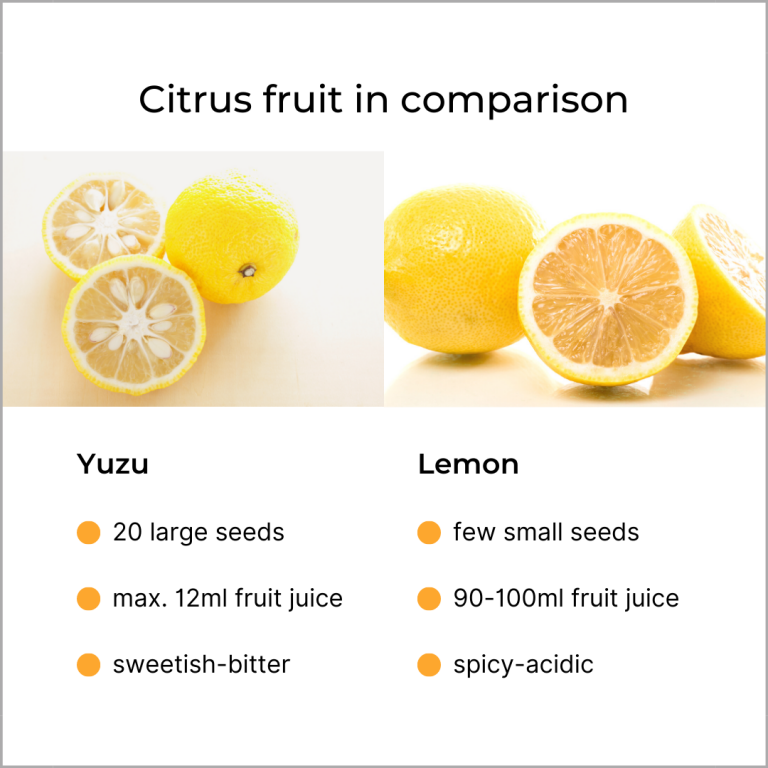
Yuzu and lemon in comparison
At first glance, there is a risk of confusion, but a
yuzu fruit is considerably larger than a lemon. It can almost reach the size of an
orange and is about the size of a tennis ball. A significant difference is revealed when you cut open the fruit. You can immediately see the
seeds, which are lined up and large at the same time. The seeds of the lemon, on the other hand, are rather small. Due to the seed size of the yuzu, only a
maximum quantity of approx. 12 milliliters of fruit juice can be extracted during the pressing process. As a result of the large seeds, the yuzu accordingly also offers little fruit flesh. Usually, a single yuzu fruit has around 20 large seeds. To obtain 100 milliliters of juice, one must squeeze about one kilogram of yuzu. The biggest difference between the two fruits lies in their aroma. While the sourness of the lemon takes the upper hand, the aroma of the yuzu is much more complex and difficult to put into words. The intense flavors and aromas of yuzu are
sweetish with a bitter note. The sweet tone of the yuzu is due to the - compared to the lemon - low acidity. This is only two-thirds of the acidity of the lemon.
Origin & distribution: Japan as a leading producer & supplier
The yuzu fruit belongs to the citrus genus (Citrus), the rue family (Rutaceae) and the soap tree order (Sapindales). The fruit itself was formed by hybridization between two different citrus fruits, namely Citrus ichangensis and Citrus reticulata (Citrus x junos). The yuzu tree, or yuzu plant, finds its origins in ancient China and was widely cultivated in the Yangtze basin, to be exact in the middle and western Yangtze River delta. Over time, it eventually found its way further into South Korea and Japan. During the Tang Dynasty (618-907) and the initial Asuka period (593-710), the yuzu tree was also cultivated in the other East Asian regions. Nowadays,
Japan has established a certain unique selling point in the export and import of yuzu and is now the market leader as the
largest producer and consumer. Much of the fruit is grown in the Japanese prefectures of Kochi, Ehime, Tokushima, the small island of Shikoku, and southern northern Japan.
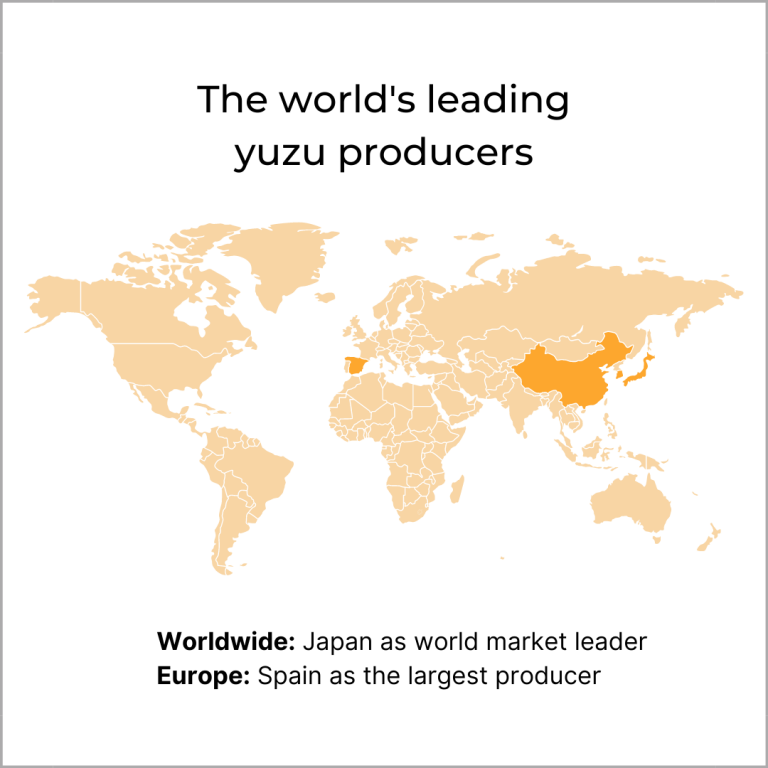
In relation, Korean agriculture, with respect to yuzu cultivation, is concentrated on Jeju Island. Although yuzu cultivation is mainly concentrated in the East Asian region,
some producers and suppliers can already be found within Europe. The European leader is Spain, where yuzu is grown with other common citrus fruits. Due to the increasing popularity of the fruit, it is expected to grow steadily within the next few years. The greater the demand, the greater the supply.
Here it is of great importance to mention that the cultivation of yuzu involves a lot of work and time. About 18 years must pass before the edible fruit emerges from the seed.
Yuzu: Superfruit and superfood at the same time
Since the beginning of cultivation, it is known that yuzu can be used as a natural remedy. Even then, people were aware that the ingredients have a positive effect on the human body. Even today, yuzu is considered a
superfood or superfruit. Like other varieties of the citrus family, yuzu has a particularly
high vitamin C content.
This is three times higher than that of the conventional lemon. Vitamin C, also known as ascorbic acid, is not only of great importance for internal metabolic processes, but also for building connective tissue (collagen), teeth and bones.
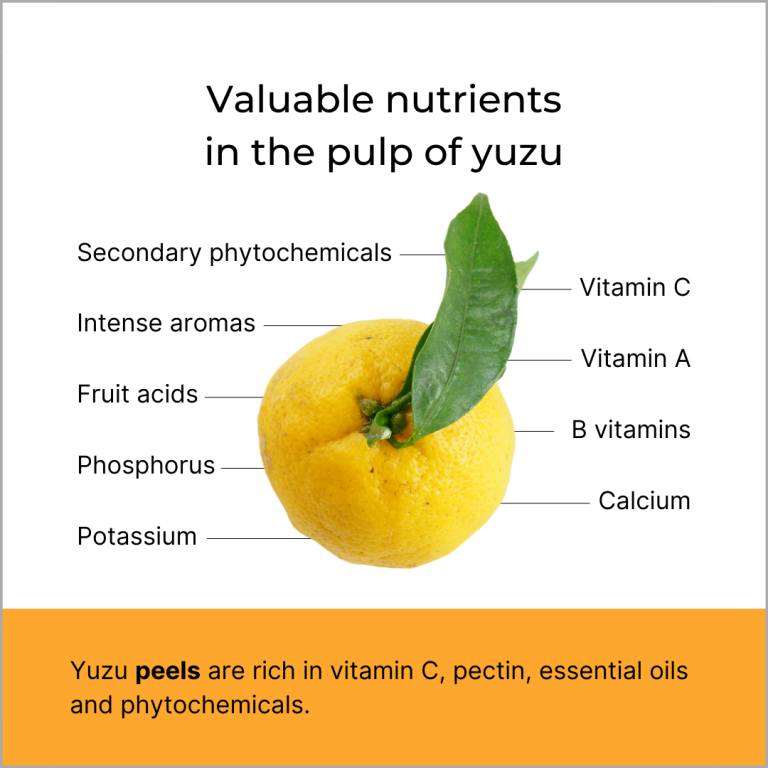
Due to the antioxidant effect of vitamin C, harmful compounds such as free radicals and reactive oxygen species are intercepted. This creates a natural protection for the molecules and cells. The plant substances of yuzu thus protect cells from oxidative stress and can thus prevent certain diseases.
Scientists of Kochi University in cooperation with Umaji Village Agricultural Cooperation proved in a study that the oil contained in the yuzu seeds, with its active ingredients such as Nomilin, can
treat mild neurodermatitis and dry skin. The oil also has a soothing effect on the so-called moonshine disease (xeroderma). Yuzu, like other citrus fruits, has a low mineral content, but it contains
many other nutrients such as
vitamin B,
phosphorus,
provitamin A,
potassium and
calcium. In addition to its use in the food industry, the scent of yuzu also acts as a driver of calm and relaxation. Yuzu aromas have a stress-reducing effect on the human organism, similar to
bergamot, which is used much more frequently here in Europe.
Use of yuzu in the food industry
In terms of use, yuzu is very diverse. In today's high-end cuisine, both in the Eastern and Western hemispheres, people rely on the properties of yuzu.
"Yuzukosho", this is the name of the
spice made from the yuzu peel. In addition to
salt and
pepper, people in Japanese cuisine often resort to yuzukosho to enhance
meat, soups and fish dishes such as salmon tartare or tuna carpaccio. In addition to yuzukosho, a
dressing mixture consisting of mirin, soy sauce and yuzu juice is very popular in practical cooking. In general, when using yuzu, care must be taken with the dosage, as the aroma and flavor can become too intense. The peel of yuzu is often used in grated form as an additive for
pasta dishes or desserts such as cakes or crepes. Given the strong aroma of yuzu, its uses spread not only to dishes but also to beverages. Yuzu often finds use in some
teas and cocktails, serving to enhance the drink. Especially yuzu preserved in
honey is often brewed with water in Korea and consumed in the form of a tea. Yuzu is also suitable as an ingredient in
functional foods and as an
extract in dietary supplements.
In traditional Japan, "yuzuyu" describes bathing in halved yuzu fruit. This bathing experience is said to strengthen the immune system and protect the respective individuals from winter colds.
Sustainability with Yuzu Gama
The most famous yuzu dish is yuzu gama ("yuzu stews"). Here, the
entire fruit is used with sustainability in mind. In this case, the skin acts as a natural eating bowl, and the upper part of the fruit is cut open so that the contents can be scooped out. Consequently, the inside is filled again with new content such as vegetables or salmon roe, with no limits to the imagination. The bright orange-yellow peel gives the food new accents and liveliness. Especially since there is a transfer of flavor to the contents and makes the whole taste even more unique. This unusual dish is served on the occasion of the New Year or for a formal Kaiseki Ryori banquet. Kaiseki (Japanese: 懐石) in German means light meal, which means that the Yuzu Gama is a light dish that is eaten, for example, at Japanese tea ceremonies.
Application of the citrus fruit in other industries
In addition to its traditional uses, yuzu has already made its way into the
cosmetics industry. In some
perfumes, yuzu plays the key note because of its intense and distinctive smell. The oils of the yuzu peel have a sweetish tone with a fruity and refreshing touch, which is why they are repeatedly used in perfumes. In addition to its use in perfume, yuzu is also sold in the form of industrial
skin products such as facial serums. For example, so-called glow serums exist that take advantage of the high vitamin C content. The moisturizing effect of the serum and the many vitamins of yuzu make the skin glow, look younger and prevent skin aging. These yuzu-based serums protect the skin from external radicals and other external influences. In addition to the above mentioned product variants, several product forms are sold on the market, these can be: Yuzu syrup, yuzu liqueur, yuzu sake, yuzu vitamin C pastilles, yuzu vapor cream, yuzu flavored incense sticks and many more.
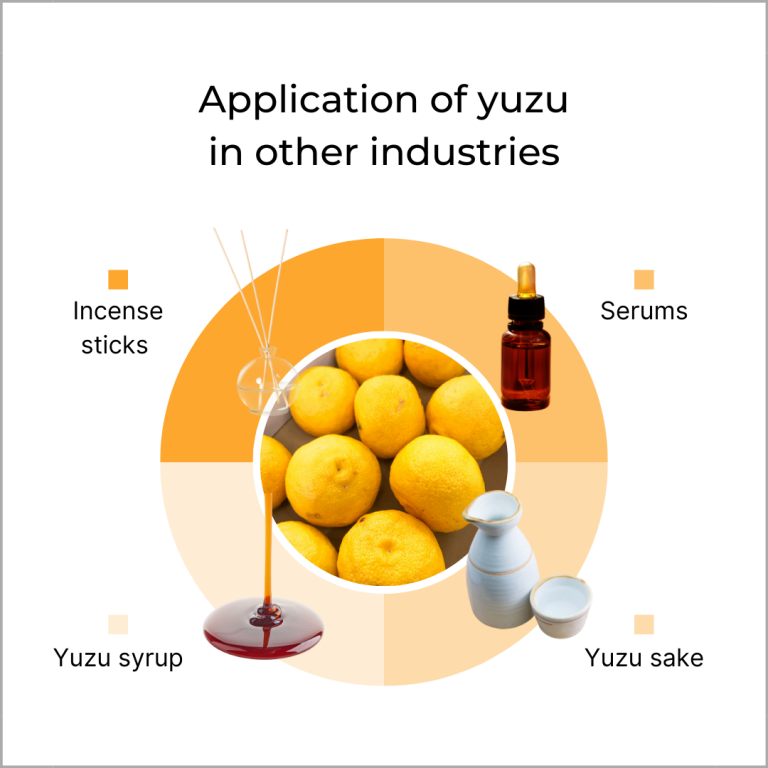
Product availability & costs
Japan as the largest yuzu producer exports only a small amount of yuzu to Europe and due to the low production in the European region, one kilogram of imported yuzu is at least 50 Euros. This corresponds to a
price of 5 to 20 euros per yuzu fruit. Thus, the yuzu is many times more expensive than a conventional lemon and is classified as a
luxury good. Due to the low export quantities, yuzu fruit is difficult to obtain in Europe.
Another influencing factor is the storage condition of the yuzu. Like other citrus fruits, the yuzu
does not continue to ripen after harvest, so it must be harvested when ripe. From this point, a
three-week period starts during which the yuzu must be processed. Otherwise it will spoil and become inedible. However, the organization and execution of logistics and transport as well as the subsequent processing in Europe pose a great challenge during this period. This complete process is very costly, time-consuming and justifies the high selling prices in the European region.
Suppliers and wholesalers of yuzu are mostly
delicatessens, online stores or Asian supermarkets. Otherwise, one must resort to alternative yuzu products such as
yuzu fruit juice, which are
much easier to obtain. Despite the rarity and small market for yuzu, this fruit is predicted to grow strongly in the coming years. The reason for this is that this fruit is simply gaining steady importance and popularity.
The lemon market as a foundation for yuzu
1.5 million tons. This is the annual amount of lemons produced in Europe. This makes Europe the world leader and leads the market ahead of the rest of the continents.
Spain in particular, as the
largest European producer and exporter, is in focus with regard to lemon cultivation. About 60% of the lemons of the total European production are based on Spanish production. The Mediterranean climate in Spain offers ideal conditions for any citrus fruit. In addition to traditional cultivation, technical advancement of cultivation has also been established. Technological progress stabilized the intensive citrus production, so that the products are
available all year round.
The lemon market can also be extended to the yuzu market. While the market for yuzu is not as large as the lemon market, some potential has definitely been created based on lemon production. A combination of the ideal growing conditions as well as general knowledge about yuzu and its benefits will lead to an intensification of yuzu production within Europe. Nevertheless, the high price of yuzu could stand in the way of a successful market entry.
Yuzu as a sustainable trend in the food industry?
Yuzu may not look like much, but its ingredients and benefits are. The citrus fruit is very versatile and offers many valuable nutrients that provide many benefits to the end consumer. Despite its high price, this superfood or superfruit offers many properties that can be used in product development and food technology.
Let’s simplify the future of change!
